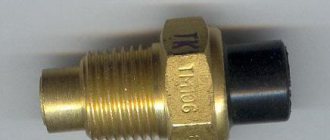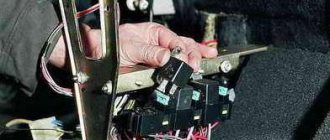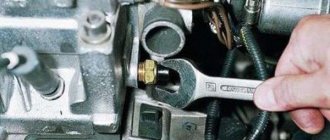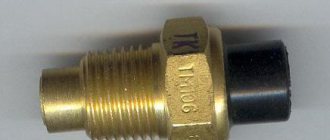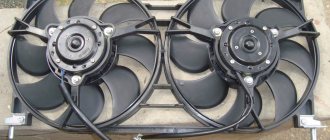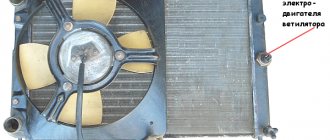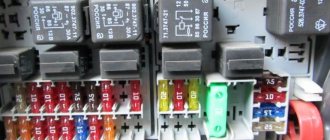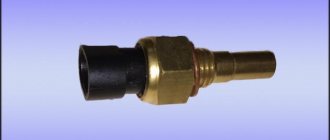The fan switch sensor is a special device that activates the fan located at the bottom of the radiator. This happens if the temperature of the antifreeze (coolant) rises and the engine overheats.
Basic functions of the radiator fan sensor
The radiator fan is one of the main devices that protects the engine from overheating not only on hot days, but also during heavy driving in traffic jams or prolonged idling.
- Its operation is evidenced by a characteristic noise emanating from under the hood of the car.
- Most often, it turns on when the engine is warm, when the radiator to remove accumulated heat is not working.
When the need arises, the fan starts and cools the thermally stressed engine for a few minutes, and when the temperature stabilizes at the desired level, the fan turns off. The radiator fan sensor is responsible for the effective operation of this system.
The thermal switch, that is, the fan sensor, performs one main and very important task: turn on the drive fan at the right time. This is usually the time when the engine coolant temperature exceeds the acceptable level.
The radiator fan sensor is responsible for preventing the fan from running continuously when it is not necessary, such as in winter. When the coolant reaches a critical temperature level, the sensor initiates the closure of the electrical circuit and the fan motor turns on.
Checking the functionality of the sensor
Checking the functionality of the device should begin with monitoring the response temperature. To do this you will need a thermometer and a multimeter. All actions can be performed independently, without resorting to a visit to the service center. If the multimeter is equipped with a thermocouple, then there is no need for a thermometer. To check the sensor, follow the instructions below:
- Switch to resistance measurement mode. For convenience, you can select the dialing mode;
- Immerse the threaded part of the sensor in water;
- Start gradually heating the water. You can control the temperature using a thermometer, or temporarily switching the multimeter to the thermocouple mode;
- Wait for the device to respond;
- Compare the temperature to which the sensor responded with the nominal value.
If there is a critical deviation of the response limit, the sensor must be replaced. After purchasing a new device, you must check its suitability. Defective products are very common on sale, so checking whether the sensor turns on correctly is the responsibility of every car owner.
Faulty radiator fan sensor
The radiator fan sensor has a tendency to cause various types of breakdowns. Their effect can be, among other things, continuous, regardless of the coolant temperature, fan operation or complete refusal to switch on the device, despite a sharp increase in the temperature of the drive unit.
In such a situation, there is nothing left but to replace the thermal switch with a new one.
- The radiator fan itself is also susceptible to malfunctions, where, for example, mechanical damage to the blades or wear to the fan shaft bearings can occur.
- Also, the viscous coupling often fails, which is usually evidenced by a rather loud noise when the fan operates or rotates at a speed equal to the speed of the drive unit.
How to check a radiator fan
Set the car heater to cold and start the car. The engine should warm up to normal operating temperature.
Let the power unit run for about five minutes, watching the temperature gauge (do not allow the car to overheat). The radiator fan sensor should automatically turn on the cooling and the temperature gauge should return to normal.
If the fan does not turn on and the temperature is constantly rising, there is likely a breakdown and you should seek professional help as soon as possible.
How much does the sensor cost?
The cost of the sensor depends on its type and car brand.
| Name | Price, rub |
| Bimetallic for domestic cars | from 250 to 400 |
| Sensor for budget foreign cars | from 700 to 1500 |
| Prices are relevant for three regions: Moscow, Chelyabinsk, Krasnodar |
The cost of sensors for some types of vehicles can reach up to 3-6 thousand rubles.
https://avtozam.com/elektronika/sensor/datchik-vklyucheniya-ventilyatora-v-avtomobile/
When should the fan turn on?
The radiator fan only operates when the engine coolant temperature reaches certain degrees. This fluid is not always found in the constantly operating part.
The fan should only run for a certain amount of time when the car is hot and then stop. If the device malfunctions, car owners may experience continuous operation. Let's take a quick look at the causes of the problem.
Radiator fan runs constantly
If the radiator fan is running all the time, this could be due to several reasons.
Here is a basic list of these reasons:
- The radiator fan switch may be faulty;
- Possible temperature sensor malfunction;
- Problems with the electrical equipment of the chassis;
- Electricity can directly reach the fan motor;
- The engine control unit may fail;
It can also be caused by different parts and systems depending on the make and model of the vehicle.
If the radiator fan is running constantly, the solution has not been made and problems may arise if it continues to be used in this way;
- The fan may completely fail due to continuous operation;
- The fan does not work, which can cause overheating problems;
- Possible problems may lead to battery discharge due to the fan starting when the car's ignition is turned off;
- This can cause different problems depending on the make and model of the car.
Where is the sensor located and how does it work?
Fan switching sensors are located on the cooling system elements. The installation point is located in the path of the fluid flow supplied from the engine jacket to the radiator. This is due to the fact that the liquid in this line will have the highest temperature.
Possible installation locations:
- thermostat housing outside the valve;
- cylinder head;
- lower radiator hose;
- side of the radiator.
On some vehicles, the sensor is combined with a coolant thermometer. The fans are turned on by the control unit based on temperature data. In this case, there is an additional sensor on the radiator that is used to operate the climate control or air conditioning. Triggering of any of the devices turns on both fans (on the engine and air conditioner radiators).
A similar solution is found on Japanese cars. On cars, two fan switching sensors can be used, located at the inlet and outlet of the radiator pipes. This scheme allows you to maintain the temperature in a narrow range.
Varieties
On cars, the following types of sensors are used to turn on the fan:
- bimetallic;
- waxy;
- thermistor;
- a sensor that operates on a circuit break or short circuit.
The first two types of sensors have an electromechanical operating circuit and can be of two varieties:
- single-speed, equipped with a single contact group that controls the fan in one temperature range;
- two-speed, equipped with a pair of contact groups configured to operate at different temperature ranges.
Regardless of the type, the sensors are a metal housing equipped with a thread. The body material used is non-ferrous metals based on copper (bronze or brass), which provide increased thermal conductivity. There is a hex key on the body that is used for installing the part. The wiring connector is located on the top of the sensor.
Bimetallic sensor
A bimetallic sensor contains a metal plate. In normal condition the contacts are open. As the plate heats up, it deforms and closes the circuit, supplying a control signal to the impeller motor turn-on relay. There are sensors that activate the fan motor directly without a relay. When the liquid cools, the plate returns to its original shape and the current supply to the motor stops.
Wax sensor
Sensors were produced for which wax or ceresite (or another substance with a significant coefficient of thermal expansion) was used as a working substance. As it warmed up, it expanded and shifted the metal membrane associated with the contacts. As it cooled, the volume of the wax decreased, and under the action of the spring the contacts opened.
Thermistor sensor
The thermistor sensor works on the principle of changing the resistance of a resistor installed in the fluid flow. The temperature change is recorded by an electronic unit, which recalculates the temperature value in accordance with the schedule.
Sensors that operate on open circuit or short circuit
Devices that turn on the fan when the circuit breaks are often found on Japanese-made cars. You can check the sensor type by removing the plug. When the block is removed from the tensile sensor, the fan will turn on.
At what temperature does the fan switch trigger?
The temperature range of the sensor response depends on the type of engine power supply. On carburetor cars, devices with a switching range of 82-110 ºС are used. The activation temperature is stamped on the body of the part. On cars of the same model, there may be sensors calibrated for different temperatures. According to the standard, sensors are divided into four groups according to operating temperature:
- 82-87 ºС;
- 87-92 ºС;
- 92-99 ºС;
- 104-110 ºС.
Russian cars use sensors of the first three groups. The engines of foreign cars are designed for more severe temperature conditions, so devices of the fourth category are often found on them.
When you start using distributed injection systems, the temperature at which the fan turns on is determined by the settings of the engine control unit. The sensor simply transmits temperature information to the control unit, which decides to turn on the fan according to the programmed program.
On injection machines, you can program temperature thresholds at which the fan switch on sensor will work. This should be done carefully, since it is easy to disrupt the temperature regime and damage the engine.
Radiator fan operating modes
When does the radiator fan turn on? The radiator fan has two different operating modes. While the first stage works slowly and continuously, the second stage works very quickly and for a short time.
The status of this level may differ depending on the car brand, but in general the levels are as follows.
- The first mode is activated in the temperature range of 60-70 degrees. The second mode begins to operate in the range of 80-95 degrees, quickly lowering the temperature of the engine coolant at a very high speed. The fan then returns to its normal first cycle,
- The radiator fan running at this high speed should change depending on the engine temperature and stop running within a range of 40 seconds to 2 hours.
- If you have a fan that runs longer than this or without stopping, or if it runs even at very low engine temperatures, this indicates serious problems.
Considering the above results, radiator fan failure due to continuous operation may be too risky and the results may be very costly. Therefore, the problem must be solved without forgetting about it.
If the radiator fan is running all the time, you can ask us all your questions, such as what is the reason and how to solve it. To ask a question, you can submit your questions by mentioning your vehicle make and model in the comments section below. We receive answers to questions asked daily.
Instructions for replacing the regulator
Replacing the fan switch almost always follows the same pattern:
- We need to prepare the “ground”. In some cars, this happens as follows: you need to rid the system of cooling liquid if the fan is installed at the bottom of the radiator, or, if the system has enough, remove water from the expansion tank. If the antifreeze needs to be completely drained, then you need to open the heater tap so that there is no residue. Important: do not pour the remaining liquid onto the ground, because antifreeze is quite poisonous.
- After this, you can remove the sensor by disconnecting the connected wires. Then, using the key, you need to remove the housing and unscrew it by hand. The new fixture must be tightened by hand, then a wrench can be used to apply the finishing touches. To prevent leakage, you can use a special thread tape, which will make the connection tighter and more reliable. After this, you can restore the contacts by returning all the necessary wires to their place, and fill the system with coolant.
Price issue
In the photographs below you can see what the device looks like, as well as estimate the cost of various models.
The request returned an empty result.
